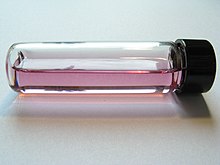A solution of [Buckminsterfullerene](https://en.wikipedia.org/wiki/Buckminsterfullerene) $\ce{(C60)}$ is shown below:

According to the April 8<sup>th</sup> [Wikipedia page](https://en.wikipedia.org/w/index.php?title=Buckminsterfullerene&oldid=945110359#Solution) on Buckminsterfullerene $\ce{(C60)}$:
> Solutions of pure C60 have a deep purple color which leaves a brown residue upon evaporation. The
reason for this color change is the relatively narrow energy width of the band of molecular levels
responsible for green light absorption by individual C60 molecules. Thus individual molecules
transmit some blue and red light resulting in a purple color. Upon drying, intermolecular
interaction results in the overlap and broadening of the energy bands, thereby eliminating the blue
light transmittance and causing the purple to brown color change.[<sup>[36]</sup>](https://en.wikipedia.org/w/index.php?title=Buckminsterfullerene&oldid=945110359#cite_note-36)
Now, I'm not too bright in the field of quantum chemistry/electrochemistry, so this doesn't click with me very well. Does anyone have a good way to explain in layman's terms why the $\ce{C60}$ solutions appear pink/purple? I'm very curious why they experience such a definite color absorption when they are made solely of carbon atoms, while most organic dyes have a host of other heteroatoms and functional groups. Also, why do they exhibit a very specific absorption *only* when in solution? Any and all contributions are greatly appreciated.